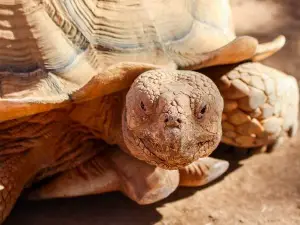
The turtle shell serves many purposes, not only is it the protective covering for the turtle but it also plays a part in the animal’s anatomy. So if something is happening with the shell, if it is turning brown, then you’d understandably be worried
This article looks into why this may be happening with your pet turtle
Table of Contents
Why is my turtle shell turning brown?
While some turtle shells are naturally brown if your pet’s shell was never brown, to begin with then you’d understandably be very worried and concerned.
Here are reasons why this may be happening with your pet’s shell:
Dust on the shell:
One simple reason why your turtle’s shell may be turning brown may be that its dust caused by the substrate you’re using. If your substrate is dry then dust can accumulate on the shell and cause it to look brown.
What to do:
You may need to pick a substrate that isn’t too dry and use this in your pet’s enclosure. If the dust is not caused by the substrate then you’ll need to determine where the dust is coming from and remove it.
Remove the dust from the animal’s shell using a soft toothbrush and some room-temperature plain water, or, you can use a wet rag to wipe your pet down.
Once you’ve washed your pet, allow it to dry outside of the enclosure.
You can use topsoil in place of the dusty soil in your pet turtle’s enclosure. Make sure that the topsoil does not have vermiculite/white moist beads in it.
Retained scutes:
Turtles need to shed their scutes to make room for new scutes. Scutes are the scale-like plates that make up the shell.
If the scutes are slow to shed, if they are long overdue to shed, then they are called retained scutes.
If you have a mix of retained scutes and new scutes then you’ll have a mix of colors on the turtle’s shell.
The normal-looking scutes are usually the new scutes and the brown ones are usually the retained scutes.
What to do:
You can help the retained scutes shed by gently brushing them using a soft toothbrush and plain room temperature water, do this weekly, doing this should help the scutes shed.
What will also help is giving your pet a blueberry or two weekly as well as wheat germ.
Make sure that the animals have an adequate basking area with proper lighting and temperature. This will allow the old scutes to become dry and brittle and fall off on their own.
Avoid peeling the scutes off, this will only cause the turtle pain and can also cause bleeding and tissue damage.
Hard water:
Another reason why your pet’s shell may be turning brown may be because it is being exposed to hard water.
Hard water is water that has a lot of minerals in it, while this may seem like a good thing it’s not. This type of water can do damage to metal faucets.
The minerals in the water can build up on your pet’s shell and can cause brown patches.
What to do:
You can check that your pet has been exposed to hard water by watching it as it basks. If the brown parts of your pet’s shell turn white during basking then hard water is the culprit
You can remedy this by using a water conditioner in your pet’s tank. Clean your pet’s water filters regularly and change the water in your pet’s tank regularly as well.
If you enjoyed this article then you may also be interested in other turtle/tortoise related articles. Here are some articles that you may be interested in: Why Are My Turtle’s Eyes Cloudy?, Why Are My Turtle’s Eyes White?, Why Is My Turtle Shell Chipping, Why Is My Turtle’s Shell Coming Off?, Why Is My Turtle Biting His Shell?, My Baby Turtle Won’t Eat, Why Is My Turtle Shell Turning Black?, Why Is My Turtles Skin Dry, Is My Turtle’s Shell Healthy?

